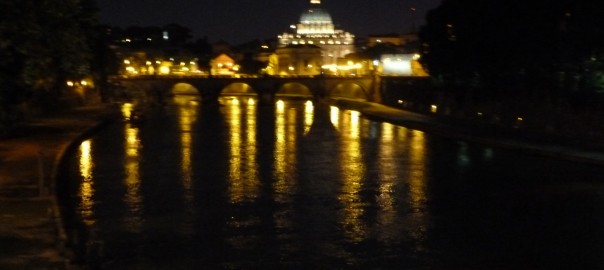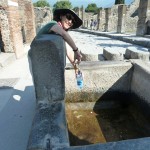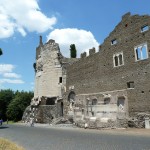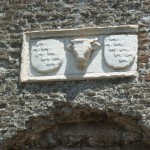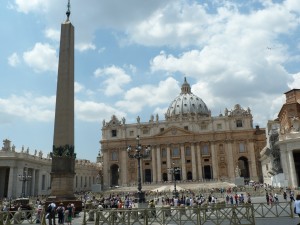Part I – Water delivery systems – led by Angela Murkowski
Part II – St Peter’s Basilica – led by Sanjay Thakur
Water is central to human existence. This essential resource has catalyzed engineering and technological achievements, inspired artistic works and architectural innovation, and has both enabled the development and contributed to the demise great civilizations. Fittingly, one of the final subjects of interdisciplinary inquiry during the SAIL Mediterranean Trivium in Italy was acqua and acquidotti.
Piazza Navona bears examination as an emblem of ancient, Renaissance, and modern water delivery in Rome. At its center is the Fontana dei Quattro Fiumi, created by Gianlorenzo Bernini in 1651. Fountains on either end depict Triton and a Moor (possibly representative of Neptune). Built upon the site of the Stadium of Domitian that occupied the site in the 1st century CE, the piazza maintains the form of the open space of the competition arena where ancient Romans came to watch the agones (“games”).
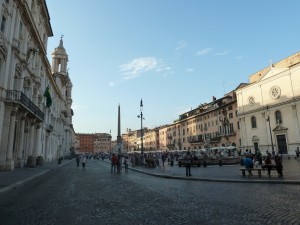
Questions that may direct interdisciplinary inquiry and discussion are:
• Where did the ancient Romans get their water and what influenced the design of acqueducts used to transport water into the city? • Is there evidence of the influence and integration of existing technologies from other cultures?
1. Persia and Assyria (region falling within modern Iraq): underground tunnel systems called qanats, that tapped into groundwater.
2. Greece:The Greeks planned their cities around springs, and also dug tunnels. In the Hellenistic period, around 300BCE, the Greeks in turn adapted Roman technology and blended late Hellenistic with early Roman technology. A distinction for Roman engineering, however, was the monumental arch.
3. Etruria: Etruscans used technology for ‘qanats’ similar those used in Assyria and Persia.
• What water sources were used, and was there a prioritization of uses for water provided by the delivery system ?
The Romans used local water sources, especially springs, to support baths in the cities. Heating of the water was necessary for warm baths, since the majority of springs in the vicinity of Rome are not hot springs: heating was achieved through use of wood, charcoal, and indentured or slave labour. Water transported into the cities ordinarily tapped groundwater, rather than surface water, because the Romans perceived the rock-filtered and limestone-laden groundwater to be cleaner. Carbonate dissolved in the groundwater caused a great deal of buildup in Roman pipes.
There were nine major aquaducts leading into ancient Rome. The Marcia, coming from the east, was the most coveted because it brought in the cleanest water. The arcades that brought the water into the city created an artificial elevation so that it would continue to flow. The huge arcades were also a visual reminder of the power and resources that Rome had in order to supply citizens with clean water. As water entered the city, it was filtered through a huge tank that served to remove silt, clay and pebbles.
The aquaducts that came into the city provided water for Roman citizens, not for native italic people who obtained water from cisterns and wells. Public water was associated with Roman citizenship and wealth, while private water was associated with poverty. According to Vitruvius, the water coming into Roman cities supplied public fountains, baths, and private homes. Angela Murkowski pointed out that this situation described by Vitruvius in his text probably was idealized.
• What are notable design features for acquaducts that transported water long distances in to Rome or Roman outposts ?
Aquaducts were constructed to move water on a 1.5 meter/1 kilometer gradient. The gradient of slopes upon pyroclastic outflow sheets from the nearby Alban Hills and Sabatini Hills influenced this aspect of the hydrogeology around Rome. Water in aquaducts moved at approximately 3-3.5 km/hour. The time required for water to travel from a spring into the city was/is 14-20 hours.
The water flowed through masonry channels, or through pipes, contained in a vaulted tunnel buried about 1 meter underground or corridor elevated above ground. These vaulted areas were large enough for one person to pass through. In the channels, there was no pressure as there is in a pipe. Rather, the surface of the channels was made smooth with lime mixed with sand or crushed brick: this smooth surface made the water travel faster. Lime from the water built up on the surface of the channels. These underground channels were marked on the ground surface in increments of ~ 70 meters with markers called cippi. Many of the masonry conduits survive.
Roman pipes were made of terracotta, lead, or wood. In northern Europe, oak was preferred, and as long as the wood remained wet, it functioned well with minimal leakage.
Bridges with arcades were exceptional means for conveying water across rivers or areas of low topography, in order to maintain the ideal gradient. Tunnels through promontories and peaks are common; ordinarily these tunnels housed pipes. Viaducts served the same purpose as a bridge–to carry water pipes over an area that could not be engineered with tunnels or other means–but they had more arches and shorter spans.
Bridges tend to be short, with arch spans as wide as possible in order to engineer the proper gradient into a bridge. Regulation basins, or holding tanks, were installed on either side of the bridge to ensure proper rate of flow. Bridges were constructed only when there was no other option. Although bridges were preferred because they could carry channels for water, which were cheaper than pipes, siphons were sometimes used to force water in pipes to flow uphill.
Constructions also controlled water distribution in a Roman city. A central castellum divisorium served as a holding tank that diverted water into specific places; with several secondary castella throughout the city that were associated with public fountains that provided water to the populace. Some very wealthy people arranged for water delivery directly into their homes. The flow of water into these homes was controlled by a bronze calyx.
• what flows in must flow out: How did Romans manage their waste water?
Waste water from public bath complexes was used in latrines before it was sent through the city’s drainage system. In larger cities on rivers, all of the waste water was dumped into the river. Rome for example had a large sewer system, the cloaca maxima, which drained into the Tiber. When a river was not convenient to a Roman city, the sewage dumped into nearby low-lying flood plains.
Following Angela’s presentation, a participant asked how the Romans dealt with droughts. Angela told us that they streamed water into cities from many different sources and that they held water in tanks to provide in times of drought.
Afternoon visit to St Peter’s Basilica (Scavi, Basilica, Cupola)
led by Sanjay Thakur
Sanjay offered some background on the history of the church, comparing it to the Duomo in Florence and the Pantheon. He explained that Peter is thought to have been martyred near Nero’s circus which was nearby. He was then buried near the spot of his martyrdom. Constantine built a church on the site, completed in 360 AD. It was in this church that Charlemagne was crowned emperor in 800. In 849, however, it was looted, leading authorities to extend the walls of the city. In 1506, Pope Julius tore down the Constantinian Basilica to building to construct a new, much larger one. It went through several designs and several designers – including Michelangelo – and moved from a Greek cross design to a Roman cross design. The Cupola also changed from a hemisphere to an oval for engineering reasons.
After visiting the church, we embarked an adventurous tour around the piazza to find the entrance to the scavi and Peter’s tomb under the church. We began by touring the Roman necropolis. One group, led by Laura, heard that the necropolis had been buried by Constantine when he had the sloping ground leveled to build the first basilica. Excavation began in 1936 and continued throughout the war. We were told that the necropolis is dated to about the second century with evidence that it was still being used as late as the fourth century (because a coin was found in an urn). Also a chi rho symbol (X P) found. This coin also helps date Constantine’s Basilica.
We saw a mausoleum with depictions of Bacchus and Horus, a child’s sarcophagus with depictions of crying parents, mosaic floors with Venus, Ares, Taurus, and a Mausoleum with a partial mosaic of Christ as Apollo with depictions of vines, Jonah, and fishing. We then viewed Peter’s tomb and heard about the scholarly debate over whether the bones found near the tomb are actually St. Peter’s. Laura explained the history of memorials on the site – from Gaius’s trophy to Constantine’s altar piece. She told us that the bones have been shown to be those of a 60-70 year old man in vigorous health.
To conclude the day and seminar activities, some returned to the hotel and others ascended to the cupola of St Peter’s Dome, for una spettacolare vista di Roma, su una bella serata ventilata!
Readings:
- Frontinus, de aquis book 1.1-23 [University of Chicago][on Rome’s various aqueducts, also demonstrative of how much Romans knew about water and engineering]
- Vitruvius, de architectura Book 8 (all)
- Heiken G. et al, Seven Hills of Rome (Chapters 1-2), Princeton University Press, 2005, 245 pp. [Available on Amazon]
- Bozzano F. et al., “A Geological Model of the Buried Tiber River Valley Beneath the Historical Centre of Rome,” Bulletin of Engineering Geology and the Environment, 59, no. 1(2000):1-21.
